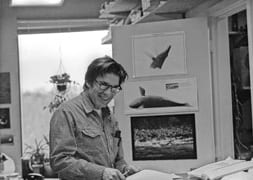William A. Watkins
The Woods Hole Oceanographic Institution announces with great sorrow the death September 24, 2004 of Oceanographer Emeritus William A. Watkins at his home in East Falmouth, MA after a long battle with multiple myeloma. He was 78.
William Alfred Watkins was a pioneer in marine mammal bioacoustics, studying the acoustic behavior of whales, dolphins, and seals in their natural environments. He was born January 8, 1926 in Conakry, French Guinea in West Africa, where his parents worked for the Christian Missionary Alliance Mission. After receiving a B.A. degree in anthropology from Wheaton College in Illinois in 1947, he worked on the college’s staff in electrical and radio systems until 1950 before returning to West Africa, where he was born and raised. Interested in linguistics, he mastered more than 30 African languages. He built and operated an international radio station (ELWA) in Monrovia, Liberia from 1951-1957. He also served as President of the West African Broadcasting Association, and was station manager and language department chief of ELWA before moving back to the United States and Cape Cod.
Although known worldwide for his marine mammal work, Bill Watkins joined the Institution staff in January 1958 as a research assistant in electronics, working with J. Brackett Hersey and later Jim Heirtzler of the Geology and Geophysics Department. William Schevill of the Biology Department, founder of marine mammal bioacoustics, immediately recognized that Bill Watkins also had unique skills for recording animals at sea, and the pair started a 40-year collaboration although Bill Watkins did not transfer to the Biology Department until 1972. He was promoted to research associate in 1963, to research specialist in 1973, and to senior research specialist in 1979, a position he held until his retirement from WHOI in 1996. He was awarded a Ph.D. in whale biology from the University of Tokyo in 1981, defending his thesis in Japanese.
During his four decades at WHOI, Bill Watkins developed many of the research tools that remain at the center of marine mammal bioacoustics: whale tags, underwater playback experiments, methods to locate marine mammal sounds underwater, and methods to identify and follow individual animals. Bill Watkins built the first tape recorder capable of recording marine mammals at sea, enabling a sudden blossoming of field studies. His first publication at WHOI was a phonograph recording of marine mammal sounds called “Whale and Porpoise Voices,” published by Watkins and Schevill in 1962. As colleague Peter Tyack notes, “Bill Watkins gave the voices of marine mammals to the world.”
hrough his long career Bill Watkins pursued research interests in acoustic pattern recognition systems, underwater acoustic behavior of marine animals, seasonal distribution and activities of cetaceans, location and tracking systems (acoustic, radio and satellite), database organization for marine animal data, cetacean vocal identity, acoustic and sonar studies of underwater animal activity, and linguistics (African language). Bill Watkins’ greatest research passion was recording animals at sea, and he continued to innovate, using naval listening gear including the SOSUS array to detect whale calls over whole oceans. While most of his peers remained content with papers in which sounds were only presented in figures, Watkins maintained a modern preoccupation with publishing actual acoustic data. During the last decade he developed a digital database with over 20,000 calls from more than 70 species of marine mammals.
Bill Watkins retired from the Biology Department in 1996 and was named the Institution’s first Oceanographer Emeritus, continuing an active research program until his death. Recently, Bill and his colleagues were involved in studies of the differences in shared calls by killer whales of the same family and pods, tracking sperm whales underwater using acoustic and radio tags, and following the seasonal distribution of large whales in the North Pacific basin using US Navy monitoring systems. His vitality and great personal force during his illness were a source of inspiration to friends and colleagues.
He is the author or co-author of more than 190 scientific publications, and was member of numerous professional societies, including the Acoustical Society of America, American Society of Mammalogists, Bioacoustics International (Editorial Board), European Cetacean Society, Oceanography Society, and the Society for Marine Mammalogy.
Away from the laboratory, Bill worked with his wife, Joan, on their dried floral business which included growing all their gardens from seed. He also enjoyed building his boat Stenella , sailing, woodworking, languages anthropology, reading, music, travel, and mechanics.
He is survived by his wife, Joan (Hennessey) Watkins of East Falmouth, MA; a brother, James Watkins of Royal Oaks, CA; three sons, Bruce W. Watkins of Truckee, CA, Stephen P. Watkins of Huntingdon, PA and James H. Watkins of Willow Grove, PA; two daughters, Sandra May of Salinas, CA, and Laurel Watney of Plano, Texas; a stepdaughter, Jennifer Malis of Salem, MA; a stepson, Matthew Maxwell of Essex Junction, VT; 12 grandchildren; and two nieces.
A celebration of life service will be held Sunday, October 10, at 2 p.m. on the 5 th floor of the Clark Laboratory on the Institution’s Quissett Campus.
n lieu of flowers, memorial donations may be made to the International Myeloma Foundation, 12650 Riverside Drive Suite 206, North Hollywood, CA 91607-3421.

